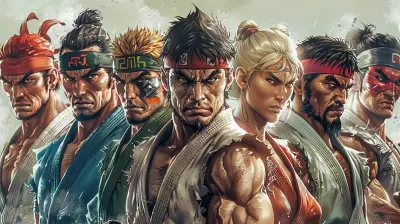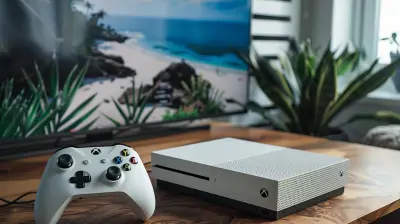In-Game Purchases: Microtransactions vs. Macrotransactions Explained
6 July 2025
Let’s face it—video games aren’t just about leveling up and chasing high scores anymore. These days, the gaming industry doesn’t just stop at the $60 you drop to get the game. Nope, a whole economy is built right into your favorite titles, and it's growing fast. I’m talking about in-game purchases.
Now, you’ve probably heard the buzzwords: microtransactions and macrotransactions. Maybe you’ve even spent a few bucks on them yourself (no judgment—we all have!). But what exactly do they mean? How do they differ? And more importantly, what impact do they have on you as a gamer?
In this article, we’ll break down microtransactions vs. macrotransactions in plain English, with real examples, gamer insights, and even a bit of friendly debate. Grab your controller—or mouse and keyboard—and let’s dig into the money-making side of gaming.
What Are In-Game Purchases, Anyway?
Before we dive into the nitty-gritty differences, let’s start with the basics.In-game purchases are exactly what they sound like: items, content, or features you can buy within a video game. Think costumes, weapons, skins, power-ups, or even entire expansion packs. Sometimes you use real money; other times you buy in-game currency and then spend that.
These purchases have become the lifeblood of many free-to-play and even AAA games. They fuel ongoing development and keep studios afloat long after a game’s initial release. But not all purchases are created equal—and that’s where micro vs. macro comes into play.
Microtransactions: Small but Mighty
What Are Microtransactions?
Microtransactions are small purchases that often cost less than $10 (sometimes even just a dollar or two). You’ve probably seen them everywhere: extra gems in a mobile puzzle game, new skins for your Fortnite avatar, or unlocking a loot box in Overwatch.They’re the quick, snack-sized buys designed to be low-pressure and tempting. They usually don’t give you a massive advantage, although that’s a whole can of worms we’ll open later.
Common Examples of Microtransactions
- Cosmetic skins (Outfits, weapons, and emotes)- Battle passes or season passes
- Loot boxes or card packs
- In-game currency (gold, gems, credits, etc.)
- Small boosts (XP boosters or energy refills)
Why Do Gamers Love (and Hate) Microtransactions?
Here’s the thing—microtransactions are convenient. You get instant gratification without breaking the bank, and for developers, it’s a dream come true for recurring revenue.But it’s not all sunshine and skins. Microtransactions have often been criticized for being manipulative, especially in free-to-play mobile games. There’s a fine line between offering fun extras and preying on people’s spending habits.
And let’s not forget the “pay-to-win” debate. If someone can buy their way to victory, is it really a fair game?
Macrotransactions: The Big Leagues
What Are Macrotransactions?
Now, macrotransactions are the big purchases. We’re talking about anywhere from $10 up to $100+ in one go. These often include full expansion packs, premium editions, or large bundles of in-game content.Sometimes they feel more “worth it” because you're getting a substantial amount of content. But they also come with a higher price tag that gives players more pause.
Common Examples of Macrotransactions
- DLC (Downloadable expansions or story packs)- Season passes unlocking content over time
- Large bundles of premium in-game currency
- Founder’s packs or Deluxe Editions
- Exclusive character packs or weapon bundles
Pros and Cons of Macrotransactions
On the plus side, macrotransactions often offer true value—more gameplay, deeper story, or cool gear that actually feels premium. And for invested players, dropping $30 on an expansion is a no-brainer if it means hours of new content.But here’s the kicker—macrotransactions can also feel paywalled. If the base game lacks substance and holds the best content behind expensive expansions, players may feel cheated.
Microtransactions vs. Macrotransactions: What’s the Real Difference?
Alright, let’s stack these two side by side and see where they shine (or stumble).| Feature | Microtransactions | Macrotransactions |
|--------|------------------|-------------------|
| Cost | Low (Usually <$10) | High ($10–$100+) |
| Content | Cosmetic or minor boosts | Substantial add-ons or content |
| Frequency | Often | Occasionally |
| Player Impact | Can be superficial or gameplay-altering | Major impact on gameplay or story |
| Emotion Trigger | Impulse buys | Considered purchases |
The Psychology of Spending in Games
Ever notice how easy it is to spend a few dollars on a skin, but you hesitate before buying an expansion? That’s not an accident. Game devs design microtransactions to feel like no big deal—just a coffee’s worth of money. But that adds up quickly.On the flip side, macrotransactions use FOMO (Fear of Missing Out) to lure you in. “Buy now and get this exclusive weapon skin!” You feel like you're getting a deal—whether you need it or not.
It's like shopping at a dollar store vs. buying a fancy gadget. One is sneaky and frequent, the other is rare but packs a punch.
The Free-to-Play Dilemma
Let’s talk about free-to-play games. They’re “free,” sure—but in reality, someone’s footing the bill. Often, developers rely on both micro and macrotransactions to make their money.Mobile games are the kings of microtransactions. Think Clash of Clans, Candy Crush, and Genshin Impact. While you technically don’t need to pay, those shiny upgrades look really tempting when you’re stuck waiting for your energy to refill.
Meanwhile, games like Warframe or Path of Exile manage to balance free content with macrotransactions in the form of cosmetic packs or expansions. In these games, paying is optional but rewarding—without punishing non-paying players too harshly.
Pay-to-Win vs. Pay-for-Fun
Here’s where things get spicy. Not all in-game purchases are created equal in terms of fairness.- Pay-to-Win (P2W): You spend money and get a competitive edge. Better weapons, stronger characters, faster upgrades. It ruins the playing field for those who don’t pay.
- Pay-for-Fun: Your purchases are cosmetic or convenience-based. Think Fortnite skins or Destiny 2 ghost shells. These don’t affect gameplay, just make it more fun or stylish.
The community tends to be cool with cosmetic items. But once real money gives players a boost in multiplayer, things turn ugly fast.
Are In-Game Purchases Hurting Games?
It depends on who you ask.From one angle, they’ve made gaming more accessible. Free-to-play models mean more people can dive in without upfront costs. Developers get funding to keep evolving the game. Win-win, right?
But there’s a darker underbelly. Some studios focus more on monetization than gameplay. You end up with half-baked titles and overpriced add-ons. Worst of all? Kids are especially vulnerable to manipulative spending mechanics.
So, as with most things in gaming, balance is key. Gamers are okay with spending money—just not feeling like they’re being milked dry.
How to Be a Smart Spender in Games
Whether you're team micro or team macro, it pays (literally) to spend wisely. Here are some quick tips:- Set a monthly game budget and stick to it.
- Watch out for impulse buys—pause before buying a loot box.
- Prioritize purchases with real value (gameplay over cosmetics).
- Be wary of games that constantly push you to spend.
- Read reviews before buying passes or expansions.
Game smart, not just hard.
The Future of In-Game Purchases
Let’s be real—microtransactions and macrotransactions aren’t going anywhere.In fact, live-service games like Destiny, Fortnite, and Apex Legends are doubling down. New content drops, seasonal events, and cosmetic bundles keep the money flowing and the players hooked.
The hope? Developers strike a balance—monetizing without exploiting, offering real value instead of flashy bait.
One thing’s for sure: as gamers, we need to stay informed, vocal, and conscious of where our money goes. Because in the end, player power drives the whole system.
Final Thoughts
So now you know—the difference between microtransactions and macrotransactions isn't just about the price tag. It's about the philosophy behind the purchase, how it affects gameplay, and how it fits into the overall gaming experience.If you’re into cosmetics and don’t mind spending a few bucks now and then, microtransactions might be your jam. But if you’re in it for meaty content and story-driven DLCs, macrotransactions are probably more your style.
Either way, the rule of thumb is simple: spend what makes you happy, but make sure it's for the right reasons.
Because at the end of the day, gaming should feel like fun—not like a checkout line.
all images in this post were generated using AI tools
Category:
In Game PurchasesAuthor:

Madeleine McCaffrey
Discussion
rate this article
2 comments
Sera Anderson
Great breakdown of microtransactions vs. macrotransactions! This clarity helps gamers make informed spending choices.
October 14, 2025 at 3:53 AM

Madeleine McCaffrey
Thank you! I'm glad you found the breakdown helpful for making informed decisions. Happy gaming!
Drake Pope
This article raises fascinating points about the evolving landscape of in-game purchases! I’m curious how microtransactions and macrotransactions impact player engagement and game balance. Do they enhance the gaming experience or detract from it?
July 13, 2025 at 4:31 AM

Madeleine McCaffrey
Thank you for your insightful comment! Microtransactions can enhance engagement by offering customization and convenience, while macrotransactions often provide substantial content at once. However, both can also risk disrupting game balance if not implemented thoughtfully. It ultimately depends on how developers integrate these systems.


